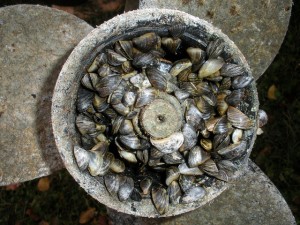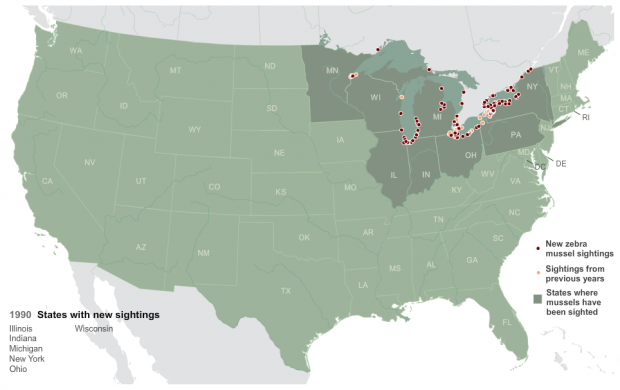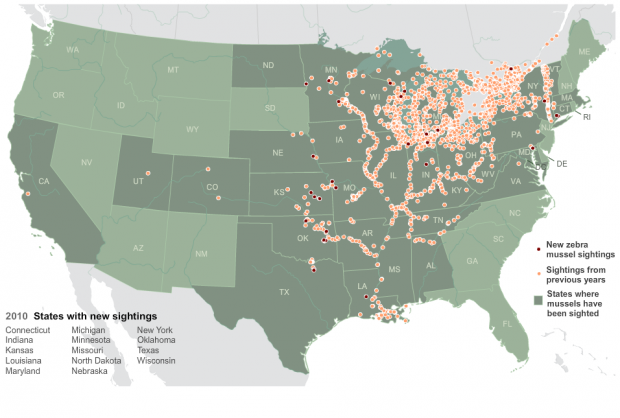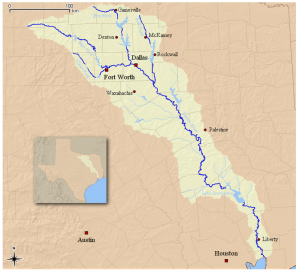How Zebra Mussels Could Raise Your Water Bill
Update 6/23: The TPWD has now announced that zebra mussels have been found in Lewisville Lake northeast of Dallas. The United States Geological Survey discovered juvenile mussels near the lake’s dam. Lewisville Lake is the third Texas lake with an established zebra mussel population. Now, they may flow downstream on the Trinity River, which could threaten Lake Livingston and, through the Luce Bayou Project, Lake Houston.
Original story: Millions of tiny mollusks in two North Texas lakes will raise the cost of water in the region as soon as this summer, and experts say they could do the same in other parts of the state.
Texas is entering its peak season for the spread of zebra mussels, a small species of invasive bivalve, and populations in Lake Texoma and Lake Ray Roberts have already caused one water district to spend millions on a new pipeline.
Brian Van Zee, an Inland Fisheries Regional Director with Texas Parks and Wildlife, has fought zebra mussels since they first arrived in Texas in 2009. He says the trick is to stop them from colonizing a new body of water.
“Once you get them into a large reservoir like we’ve got here in Texas, there’s really no way of eradicating them,” Van Zee said.
Zebra mussels originate from Eastern Europe, and were first found in the Great Lakes in the late 1980s. They have since spread throughout the country, infecting over 600 bodies of water in 27 states.
The mussels can devastate both ecosystems and man-made infrastructure. They cling together in dense clusters that can sink boats, kill organisms, and clog pipelines. Like many invasive species, they multiply rapidly and gobble up valuable resources.
Although officials from Millbrook Quarry in Brentsville, Va. used potassium chloride to successfully eliminate a zebra mussel population in 2006, experts say similar efforts in Texas’ two infested lakes would be practically impossible.
Millbrook Quarry covers an area of just over 12 acres – much smaller than Lake Texoma (89,000 acres) or Lake Ray Roberts (29,350 acres). According to Van Zee, “there’s no way” to pay for enough potassium chloride to get rid of all the mussels in those lakes. Other eradication methods might kill organisms besides zebra mussels or cause irreparable damage to the lake.
Instead, Van Zee can only try to prevent the mussels from entering other bodies of water. That’s especially difficult during the summer, when Texas lakes stand the greatest risk of infestation.
“Any time you get increased use of those lakes, particularly this time of year when you might have increased zebra mussel larvae in the water, then there’s a greater chance that they might get transported to another water body,” Van Zee said.
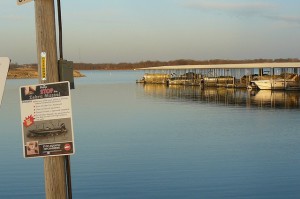
Photo by flickr user LauraGilchrist4
A sign in Smithville, Missouri warns boaters about zebra mussels.
Zebra mussel larvae can move from lake to lake by attaching themselves to a watercraft. Even if boaters follow the prescribed prevention protocols, larvae can survive outside the water for up to two weeks in the right conditions.
That’s how Van Zee believes the zebra mussels spread to Lake Texoma in the first place. And their presence has impacted more than just boating and fishing.
Water Utilities Preparing for the Worst
The North Texas Municipal Water District serves two of the fastest growing cities in the nation, Frisco and McKinney. In total it provides water to over 1.6 million people north of the Dallas-Fort Worth Metroplex.
Prior to its infestation, Lake Texoma provided 28% of the area’s total water supply. The district would pipe water 80 miles south from Lake Texoma to Lavon Lake in Wylie. That water would then be treated at the Wylie Water Treatment Plant before being supplied to customers.
That changed in 2009 when zebra mussels were discovered in Lake Texoma. Suddenly Lavon Lake was at risk of infestation, so the Water District stopped piping from Texoma altogether.
Now, it is building a new pipeline directly from Lake Texoma to the Wylie Water Treatment Plant. The mussel-stricken water will be treated there with chlorine and ozone to eradicate the larvae and make the water safe for consumption.
That’s not a cheap undertaking. The project’s $300 million price tag was passed on to the Water District’s customers, whose water bills increased by approximately 14%.
The cost doesn’t surprise Dr. Robert McMahon. As an aquatic biologist with the University of Texas at Arlington, he has studied the zebra mussel since its arrival in Texas.
“This is not a cheap animal,” McMahon said. “Believe me, other water companies and utilities are … making their own estimates [of expenses] too. They want to be prepared.”
McMahon doesn’t know when the mussels will spread, but he has found zebra mussel DNA in Lewisville Lake, Lake Bridgeport, and Lake Bob Sandlin. From Lewisville Lake, they could travel down the Trinity River into Lake Livingston and Lake Ray Hubbard.
As the population spreads, so too will the expense. According to McMahon, any new pipeline built from a Corps of Engineers lake will have to include systems to prevent larvae transfer.
“Those design features are going to cost money,” McMahon said. “That’s going to increase [bills].”
No solution in sight?
Despite the presence of the new pipeline from Lake Texoma, there’s no guarantee that it will fulfill one of its primary purposes.
According to Water District spokeswoman Denise Hickey, zebra mussels “may very well enter into [Lavon Lake],” because of public watercraft.
Without a guaranteed solution, Van Zee has spent the last few years implementing a public awareness campaign to educate boaters on the consequences of zebra mussel transmission and what they can do to stop it. After some initial indifference, he thinks that the efforts are catching on.
“I think there’s more and more individuals around the state who have become aware of [zebra mussels],” he said. “With any issue, when it first pops up…a lot of people overlook it. ‘It’s not in my area, it doesn’t concern me.’ Unfortunately it takes for [the problem] to spread for…you to start getting some impacts.”
But just being aware of the problem may not be enough. Grayson County Game Warden Dale Moses has seen the “impacts” Van Zee is talking about. His jurisdiction includes Lake Texoma, and stopping the spread of zebra mussels has become a huge part of his job. Transporting zebra mussels in Texas is a class C misdemeanor.
“I don’t have a count or anything since I’ve caught so many [boats transporting mussels],” Moses said.
Every day, Moses assesses the damage that the mussels cause. In his opinion, it’s only a matter of time before they infest other Texas lakes.
“Eventually, they’ll be throughout the state,” Moses said. “And they’ll pass that cost on to consumers.”
Michael Marks is a reporting intern with StateImpact Texas.
